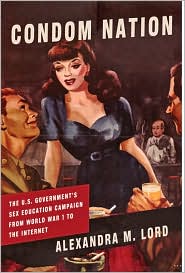 Concerns about the spread of syphilis and gonorrhea during World War I lead the federal government to launch a sex education campaign. These campaigns were aimed primarily at young boys and men and may be seen as precursor's to today's "abstinence-only" programs. Young men were admonished through classes, pamphlets and slide shows, to avoid contact with prostitutes, lest they carry the disease, and to "keep fit" by demonstrating "self control". Over the next nine decades the Public Health Service would carry on the battle over unwanted pregnancies, abortion, and, eventually, AIDS, delivering messages through all types of media, and in the classroom, while attempting not to offend any constituencies. There was no way to carry out this task without failure. Today, as the United States' teen pregnancy rate continues to outpace that of other developed countries, the Religious Right still manages to call the shots on sex education.
Concerns about the spread of syphilis and gonorrhea during World War I lead the federal government to launch a sex education campaign. These campaigns were aimed primarily at young boys and men and may be seen as precursor's to today's "abstinence-only" programs. Young men were admonished through classes, pamphlets and slide shows, to avoid contact with prostitutes, lest they carry the disease, and to "keep fit" by demonstrating "self control". Over the next nine decades the Public Health Service would carry on the battle over unwanted pregnancies, abortion, and, eventually, AIDS, delivering messages through all types of media, and in the classroom, while attempting not to offend any constituencies. There was no way to carry out this task without failure. Today, as the United States' teen pregnancy rate continues to outpace that of other developed countries, the Religious Right still manages to call the shots on sex education. This book had some great vintage images of pamphlets with a window on social morés of the times. Even while there has always been evidence of a large portion of the population engaging in pre-marital and extra-marital sex, the messages were clear that only sex within marriage was the accepted norm. The book also provides good insight into how the government managed to get any information out to the public despite the fact that there have always been vocal minorities who wanted to quash any attempt to educate the masses about sexual health. It was especially interesting to learn that even almost one hundred years ago the government made some attempt to create culturally sensitive materials for African-American and immigrant communities.
Although libraries are mentioned only a few times in this work, the author makes it clear that they were important to her research. Acknowledgements go to individuals at the National Archives, the National Library of Medicine, the Kautz Family YMCA Archives, and Social Welfare History Archives at the University of Minnesota. As well, several of the images in the book are credited to these libraries. She also acknowledges her parents, who introduced her "to the joys of libraries and reading", and who taught her to "look it up!"
The role of libraries as information providers in the government's quest is seen through a lens of censorship. Following World War I the government continued its attempt to eradicate venereal diseases through education campaigns. Schools, newspapers, civic organizations, and churches were involved, as were libraries, some of which defied local censors by "boldly placing the Public Health Services pamphlets on syphilis and gonorrhea on their shelves and then publicizing the fact in the local newspaper" (p. 62).
A discussion of the Religious Right during the last part of the 20th century tells us that "efforts such as purging the local library of works that [it] deemed morally questionable, along with attempts to ban the teaching of evolution and sex education dominated the movement throughout the early 1970s" (p. 143). Of course, the Religious Right, and any number of other organizations, and individuals, continue to attempt to restrict the rights of others to choose what they want to read. See my Banned Books Week page for more information.
No comments:
Post a Comment